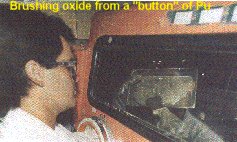 Another example of a
typical plutonium processing operation.
Another example of a
typical plutonium processing operation.




All plutonium originates in nuclear reactors and is produced by the capture of
extra neutrons by uranium-238 to form U-239, which then undergoes a series of decays
to form Pu-239:
U-238 + n -> U-239 -> Np-239 -> Pu-239
Some of this plutonium gets consumed by fission before it is removed from the
reactor, and some of it gets transmuted to heavier isotopes of plutonium by capturing
more neutrons:
Pu-239 + n -> Pu-240
The isotopic composition of plutonium is affected by how long it stays in the reactor. Short exposures produce plutonium with very little Pu-240 and with very little plutonium being consumed by fission. Long exposures produce high Pu-240 concentrations, and a substantial portion of the plutonium produced is consumed by fission.
The isotopic composition matters with regard to manufacturing weapons for two reasons.
In the earliest years of weapon design the emission of neutrons was a problem in making a reliable efficient weapon because of the problem of predetonation. A high neutron flux makes it difficult or impossible to compress a bomb core containing several kilograms of plutonium to supercriticality before the bomb disassembled with a greatly reduced yield. The advent of composite cores containing highly enriched U-235 and plutonium (in the late 1940s) greatly reduced this difficulty though since the option of using a relatively small amount of plutonium in a mostly uranium core became available. The later development of fusion boosted weapons (in the mid 1950s) eliminated it entirely since the fusion boosting effect ensures efficient weapons, even with low initial fission yields.
Plutonium can be obtained from special purpose plutonium production reactors, or as a by-product of commercial power or research reactors. The plutonium produced by special purpose production reactors has a relatively low Pu-240 content (<7%) and is called "weapons grade", while commercial reactors may produce plutonium with Pu-240 with concentrations of >20% and is called "reactor grade".
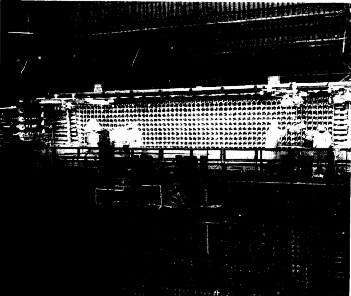
At left is the
loading face of the world's first plutonium production reactor, the B-Reactor located
at Hanford Washington. Uranium fuel rods were inserted in the holes for
irradiation.
Essentially all of the plutonium currently in weapons throughout the world was produced in special purpose plutonium production reactors. Initially each of the five declared nuclear powers began producing plutonium for weapons on a large scale many years before they developed significant numbers of commercial power reactors. Special purpose reactors were required for weapons production because there was no other sources of plutonium available.
These special purpose reactors produce "weapon grade" plutonium, as opposed to
grades with higher Pu-240 concentrations, for two reasons:
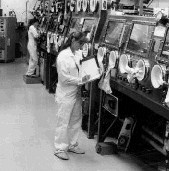
The actual
fabrication and processing of plutonium is done manually in glove boxes like these,
which means there is negligible shielding between the operator and the
neutron-emitting plutonium. If higher Pu-240 plutonium were used in weapons, then
either remote control processing cells would have to be used, or the number of hours
that each worker could spend at these tasks would have to be sharply reduced. Either
of these would drive up the cost of weapon processing considerably. It is for this
reason, as well as historical and policy reasons, that explain why reactor grade
plutonium is not used in U.S. weapon. It is not due to any inherent inability to do
so (contrary to some statements made by the nuclear power industry).
 Another example of a
typical plutonium processing operation.
Another example of a
typical plutonium processing operation.
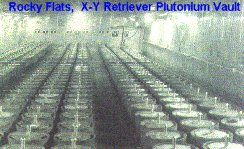
At left is the X-Y
plutonium storage facility at Rocky Flats. This facility is now shut down, but
plutonium is still stored there. The plutonium is stored in sub-critical units, that
are carefully spaced in a rectangular ("X-Y") grid to prevent criticality accidents.
The manipulation of the plutonium is handled by remote control machinery - partly for
security, partly due to radiation exposure hazards.
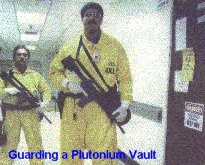
Due to the
extremely serious consequences of unauthorized acquisition of plutonium, the X-Y
facility is heavily guarded.
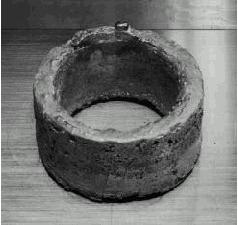
This ring of electrorefined plutonium metal has a purity of more than 99.96 per cent.
It is typical of the rings that were prepared at Los Alamos and shipped to Rocky
Flats for weapon fabrication before the latter faciltiy was shut down, and U.S.
weapon manufacture halted.
The ring weighs 5.3 kilograms, enough for one bomb core, and is approximately 11
centimeters in
diameter. The ring shape is important for criticality safety. There is enough
plutonium in this ring to make a modern strategic nuclear weapon.

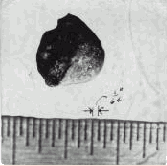
This is
history's first gram-scale sample of plutonium metal ever fabricated (weight 520
milligrams), made by Ted Magel and Nick Dallas at Los Alamos on March 23,
1944.
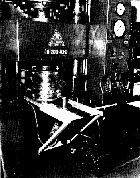
This is the Los Alamos press that
fabricated the plutonium
cores for the Trinity and Nagasaki bombs. It hot-pressed the plutonium-gallium alloy
into the required hemispherical shapes.
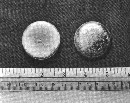
These
buttons of refined plutonium metal were used in the core
of the Fat Man bomb dropped on Nagasaki.